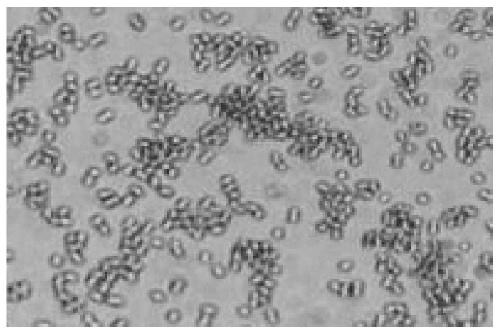A kind of Aeromonas bacterial strain r1 and its preparation method and its application in algalytic degradation of microcystins
A microcystin and Aeromonas technology, applied in biochemical equipment and methods, chemical instruments and methods, and microbial-based methods, can solve problems such as single function and less research
- Summary
- Abstract
- Description
- Claims
- Application Information
AI Technical Summary
Problems solved by technology
Method used
Image
Examples
Embodiment 1
[0043] Screening and Identification of Strain R1
[0044] S1: Centrifuge the rotten algae bloom collected from Jinghu Lake, Jinghu District, Wuhu City, Anhui Province, and collect the supernatant;
[0045] S2: Inoculate 10 mL of the supernatant into 90 mL of beef extract-peptone liquid medium under aseptic conditions, and shake at 180 r / min and 37°C for 24 hours to obtain the bacterial liquid;
[0046]S3: Inoculate 0.1 mL of the bacterial solution onto beef extract peptone solid medium containing 10 mg / L cadmium, and incubate at 37°C for 72 days;
[0047] S4: The well-growing colony was purified and inoculated into the slant medium, stored at 2-6°C until use, and named as R1.
[0048] In the step S4, the purification method is to pick the colony on the beef extract peptone solid medium, connect the cadmium-containing beef extract peptone medium by the streaking method, culture the plate upside down, and then pick the colony and continue to repeat the previous steps, until th...
Embodiment 2
[0052] Algae lysis test
[0053] A ring of R1 strain was inoculated into 200mL beef extract-peptone liquid medium, cultured at 180r / min and 37°C for 30h to obtain R1 strain, which had an absorbance value of 1.0 at 620nm. The preparation method of the R1 bacterial solution involved in the following examples is the same.
[0054] The preparation method of the Microcystis aeruginosa algae liquid is as follows: the purchased algae are inserted into the BG11 medium, and the algae are shaken every day, and cultivated in a light incubator at 25° C., light intensity 2500 lx, and light-dark ratio 12h:12h.
[0055] The algae-dissolving test was designed according to Table 1.
[0056] Table 1 algae-dissolving test
[0057]
[0058]
[0059] Each group of experiments was repeated three times, cultured at 25°C, light intensity 2500lx, and light-dark ratio 12h:12h, observed the morphological changes of Microcystis aeruginosa cells and measured the content of chlorophyll a in algae c...
Embodiment 3
[0061] Degradation Test of Algal Toxins by R1 Strain
[0062] Put the R1 bacterial solution cultivated for 24 hours into the M9 medium with microcystin as the substrate according to the volume ratio of 5%, the initial concentration of algae toxin is 1.84mg / L, and the concentration of cadmium is 0.1mg / L; another experimental group, The M9 medium only contains algae toxin, the concentration is 1.84mg / L, and a negative control group is set up. Cultivate in a shaker at 37°C and 180r / min for 7 days, take a sample every 24 hours, and detect changes in the content of algal toxins with a microcystin detection kit produced by Beacon. Detection method: pipette 50 μl of enzyme markers into the small wells of the microwell plate; pipette 50 μl of the standard sample, sample, and negative control into the corresponding microwells; add 50 μl of antibody solution to each space, and incubate the film for 30 minutes with rapid shaking; wash the microwell with the cleaning solution Wells were ...
PUM
| Property | Measurement | Unit |
|---|---|---|
| absorbance | aaaaa | aaaaa |
Abstract
Description
Claims
Application Information
 Login to View More
Login to View More - R&D
- Intellectual Property
- Life Sciences
- Materials
- Tech Scout
- Unparalleled Data Quality
- Higher Quality Content
- 60% Fewer Hallucinations
Browse by: Latest US Patents, China's latest patents, Technical Efficacy Thesaurus, Application Domain, Technology Topic, Popular Technical Reports.
© 2025 PatSnap. All rights reserved.Legal|Privacy policy|Modern Slavery Act Transparency Statement|Sitemap|About US| Contact US: help@patsnap.com



